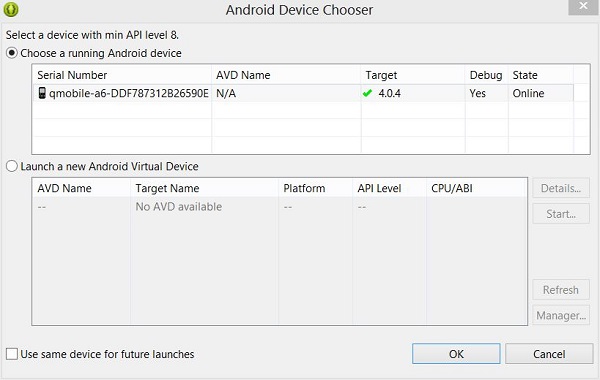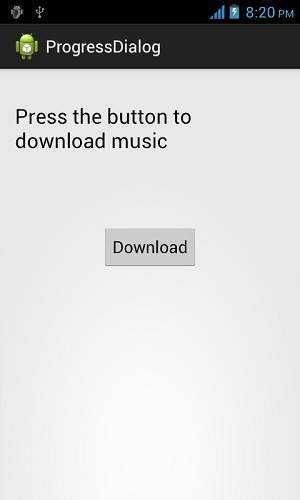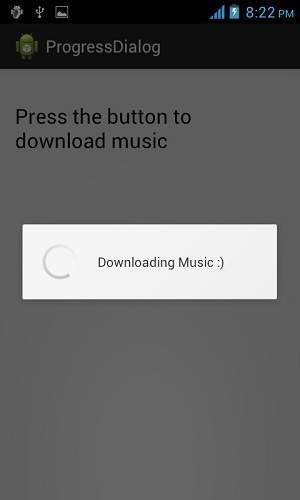Android Progress Circle Tutorial
The easiest way to make a progress circle is using through a class called ProgressDialog. The loading bar can also be made through that class. The only logical difference between bar and circle is , that the former is used when you know the total time for waiting for a particular task whereas the later is used when you donot know the waiting time
In order to this , you need to instantiate an object of this class. Its syntax is.
ProgressDialog progress = new ProgressDialog(this);
Now you can set some properties of this dialog. Such as , its style,its text e.t.c
progress.setMessage("Downloading Music :) "); progress.setProgressStyle(ProgressDialog.STYLE_SPINNER); progress.setIndeterminate(true);
Apart from these methods, there are other methods that are provided by the ProgressDialog class
Sttle and description| Sr. NO | |
|---|---|
| 1 | getMax() This methods returns the maximum value of the progress |
| 2 | incrementProgressBy(int diff) This method increment the progress bar by the difference of value passed as a parameter |
| 3 | setIndeterminate(boolean indeterminate) This method set the progress indicator as determinate or indeterminate |
| 4 | setMax(int max) This method set the maximum value of the progress dialog |
| 5 | setProgress(int value) This method is used to update the progress dialog with some specific value |
| 6 | show(Context context, CharSequence title, CharSequence message) This is a static method , used to display progress dialog |
Example
This example demonstrates the spiining use of the progress dialog. It display a spinning progress dialog on pressing the button.
To experiment with this example , you need to run this on an actual device on after developing the application according to the steps below.
| Steps | Description |
|---|---|
| 1 | You will use Eclipse IDE to create an Android application and name it as ProgressDialog under a package com.example.progressdialog. While creating this project, make sure you Target SDK and Compile With at the latest version of Android SDK to use higher levels of APIs. |
| 2 | Modify src/MainActivity.java file to add progress code to display the spinning progress dialog. |
| 3 | Modify res/layout/activity_main.xml file to add respective XML code. |
| 4 | Modify res/values/string.xml file to add a message as a string constant. |
| 5 | Run the application and choose a running android device and install the application on it and verify the results. |
Following is the content of the modified main activity filesrc/com.example.progressdialog/MainActivity.java.
package com.example.progressdialog; import com.example.progressdialog.R; import android.os.Bundle; import android.app.Activity; import android.app.ProgressDialog; import android.view.Menu; import android.view.View; public class MainActivity extends Activity { private ProgressDialog progress; @Override protected void onCreate(Bundle savedInstanceState) { super.onCreate(savedInstanceState); setContentView(R.layout.activity_main); progress = new ProgressDialog(this); } public void open(View view){ progress.setMessage("Downloading Music :) "); progress.setProgressStyle(ProgressDialog.STYLE_SPINNER); progress.setIndeterminate(true); progress.show(); final int totalProgressTime = 100; final Thread t = new Thread(){ @Override public void run(){ int jumpTime = 0; while(jumpTime < totalProgressTime){ try { sleep(200); jumpTime += 5; progress.setProgress(jumpTime); } catch (InterruptedException e) { // TODO Auto-generated catch block e.printStackTrace(); } } } }; t.start(); } @Override public boolean onCreateOptionsMenu(Menu menu) { // Inflate the menu; this adds items to the action bar if it is present. getMenuInflater().inflate(R.menu.main, menu); return true; } }
Modify the content of res/layout/activity_main.xml to the following
<RelativeLayout xmlns:android="http://schemas.android.com/apk/res/android" xmlns:tools="http://schemas.android.com/tools" android:layout_width="match_parent" android:layout_height="match_parent" android:paddingBottom="@dimen/activity_vertical_margin" android:paddingLeft="@dimen/activity_horizontal_margin" android:paddingRight="@dimen/activity_horizontal_margin" android:paddingTop="@dimen/activity_vertical_margin" tools:context=".MainActivity" > <Button android:id="@+id/button1" android:layout_width="wrap_content" android:layout_height="wrap_content" android:layout_alignParentTop="true" android:layout_centerHorizontal="true" android:layout_marginTop="150dp" android:onClick="open" android:text="@string/download_button" /> <TextView android:id="@+id/textView1" android:layout_width="wrap_content" android:layout_height="wrap_content" android:layout_alignParentRight="true" android:layout_alignParentTop="true" android:layout_marginTop="19dp" android:text="@string/download_text" android:textAppearance="?android:attr/textAppearanceLarge" /> </RelativeLayout>
Modify the res/values/string.xml to the following
<?xml version="1.0" encoding="utf-8"?> <resources> <string name="app_name">ProgressDialog</string> <string name="action_settings">Settings</string> <string name="hello_world">Hello world!</string> <string name="download_button">Download</string> <string name="download_text">Press the button to download music</string> </resources>
This is the default AndroidManifest.xml
<?xml version="1.0" encoding="utf-8"?> <manifest xmlns:android="http://schemas.android.com/apk/res/android" package="com.example.progressdialog" android:versionCode="1" android:versionName="1.0" > <uses-sdk android:minSdkVersion="8" android:targetSdkVersion="17" /> <application android:allowBackup="true" android:icon="@drawable/ic_launcher" android:label="@string/app_name" android:theme="@style/AppTheme" > <activity android:name="com.example.progressdialog.MainActivity" android:label="@string/app_name" > <intent-filter> <action android:name="android.intent.action.MAIN" /> <category android:name="android.intent.category.LAUNCHER" /> </intent-filter> </activity> </application> </manifest>
Let's try to run your ProgressDialog application. I assume you have connected your actual Android Mobile device with your computer. To run the app from Eclipse, open one of your project's activity files and click Run  icon from the toolbar. Before starting your application, Eclipse will display following window to select an option where you want to run your Android application.
icon from the toolbar. Before starting your application, Eclipse will display following window to select an option where you want to run your Android application.
 icon from the toolbar. Before starting your application, Eclipse will display following window to select an option where you want to run your Android application.
icon from the toolbar. Before starting your application, Eclipse will display following window to select an option where you want to run your Android application.
Select your mobile device as an option and then check your mobile device which will display following screen:

Just press the button to start the Progress Dialog. After pressing , following screen would appear


Comments
Post a Comment